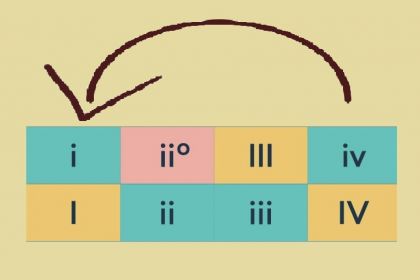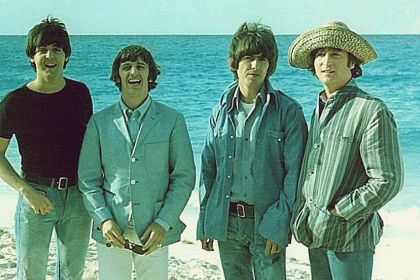Music Theory
Beatles songs with harmonic minor and Aeolian modes

Like Some Forgotten Dream book cover
One of the easily explained reasons for the continued popularity of The Beatles' songs lies in their harmonic structure that often follows the canons of the tonal theory. Indeed, around half of the band's self-written songs draw on six diatonic modes, namely the Ionian, Dorian, Phrygian, Lydian, Mixolydian, and Aeolian.
These diatonic modes are the most convenient tool for composing homophonic music in which the melody and chord accompaniment harmonize with ease. As the dominant form of most vocal genres in classical music, homophonic texture naturally migrated to the pop segment where it remained a useful tool for many songwriters.
The Beatles output shows a clear dominance of the major diatonic modes over the minor ones. Out of all their self-penned tracks, 64 use three major modes (Ionian, Lydian, and Mixolydian) and only 13 show examples of the minor modes (Aeolian, Dorian, and Phrygian). Curiously, Led Zeppelin also favors the major scales, while The Doors and Pink Floyd have roughly equal numbers of minor and major compositions.
Of all the three minor diatonic modes, Aeolian prevails in classical and pop music due to its flexible structure, while Dorian and Phrygian are comparatively less utilized and have the status of modal modes. The harmonic structure and key features of the Aeolian mode (based on the natural minor scale) are discussed in detail in our article on 8 songs to introduce Aeolian mode and natural minor scale.
Of the eight Beatles songs featuring the Aeolian mode, the best one to convey the concept of the mode chord structure is perhaps The Long And Winding Road. In the harmonic analysis of the six-line verse chord chains, the scale degrees (denoted with Roman numerals) show the following progressions in the key of C minor:
- Cm–A♭ or i–VI;
- E♭–E♭7–A♭ or III–III7–VI;
- Gm–Cm or v–i;
- Fm–B♭–E♭–E♭7 or iv–VII–III–III7;
- A♭–Gm–Cm or VI–v–i;
- Fm–B♭–E♭ or iv–VII–III.
The progressions show a clear application of all Aeolian mode chords except the iio diminished supertonic chord rooted in the second scale degree. The v–i authentic cadence is observed here in its classic form, closing the chord progressions in the 3rd and 5th lines.
Vocal bridge and instrumental solo are performed with the chord chain E♭–A♭–Gm–Fm–B♭ or III–VI–v–iv–VII. The progression lacks the Cm tonic chord, thus creating its anticipation at the beginning of the upcoming stanza
Listen to The Long And Winding Road (Remastered 2009) by The Beatles:
In a rather truncated form, the Aeolian mode is seen in Eleanor Rigby mostly accompanied by a two-chord alternation: Em–C–Em or i–VI–i. Another variation is introduced by the Em7 and Cmaj7 seventh chords, sometimes appearing instead of triads, as well as the Am subdominant chord rooted in the fourth scale degree that complements the third verse progression.
Note that this song progression can be classified as both Aeolian and Phrygian since the structure of the chords rooted in the first, fourth, and sixth scale degrees are exactly the same in these modes.
Listen to Eleanor Rigby (Remastered 2009) by The Beatles:
In songwriting, it is not uncommon to blend two modes within a composition in order to create a harmonic contrast between different song sections or highlight certain musical phrases. A fine example of the combination of the Aeolian and Phrygian minor modes appears in Things We Said Today. The harmonic analysis of this song can be found in the article covering the only Beatles song featuring Phrygian mode.
Some Aeolian elements can be found in Don’t Bother Me based on the Dorian progressions explained in the article on the Beatles songs with Dorian mode.
A well-known shortcoming of the natural minor scale is the lack of the leading tone which excludes the usage of the perfect authentic cadence—the most important musical turnaround that helps generate a sense of completion in any given musical phrase. This inconvenience is usually rectified by the episodic introduction of the harmonic minor scale, in particular the major dominant chord rooted in the fifth scale degree. The major dominant chord lends its leading tone to create pronounced completeness within the V–i cadence.
You Never Give Me Your Money showcases a classic example of the V–i authentic cadence that involves a major dominant chord and a minor tonic chord, both appearing here to close the verse. For harmonic analysis of the song, see our article on authentic cadence exemplified by The Beatles songs
The major dominant chord can also be used in Aeolian-mode half cadences that usually end the antecedent musical phrase, producing an interrogative tone and creating anticipation for the musical thought to continue. Two examples of these half authentic cadences closing the second line of the verses can be observed in I'm Only Sleeping and Girl. Explore the harmonic progressions of both tracks in the article on 6 songs combining harmonic minor and Aeolian mode.
In Golden Slumbers, the major dominant chord opens the refrain "sleep pretty darling, do not cry, and I will sing a lullaby," thereby creating a certain harmonic contrast to highlight the phrase. Read more about the lyrical origins of the famous Beatles lullaby.
Discover more songs combining the Aeolian mode with the harmonic minor scale and check out their harmonic analysis in the following articles:
- 6 songs combining harmonic minor and Aeolian mode
- Bungle in the Jungle: early prog-rock hit vs the greatest boxing match
- Butterflies and Hurricanes: piano intermezzo meets the chaos theory
- Porque Te Vas: origin and meaning behind Jeanette's best song
- Quimbara: meaning and origin of the best-known salsa
- Mariposa Traicionera: meaning and flamenco roots of Maná's top hit
- Livin' la Vida Loca: why is Ricky Martin's best song so catchy?
- A Dios le Pido: Juanes' Spanish lyrics behind the song success
- Suavemente: meaning of Elvis Crespo's best song
- El Farsante and 7 more songs by Ozuna in Dorian and Aeolian modes
- La Gota Fría: vallenato music masterpiece refashioned by Carlos Vives
- Vivir Mi Vida: meaning and origin of Marc Anthony's jubilant salsa










